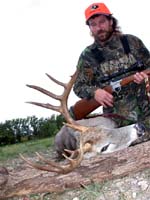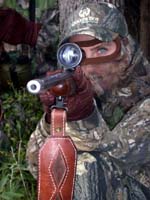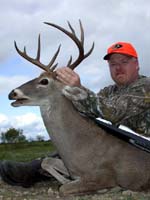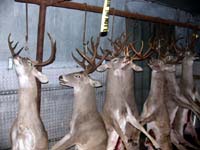
|
Features
|
|
|
|
Books
|
|
|
|
Fun & Games
|
|
|
|
Contact Us
|
|
|
John's Journal... Entry 250, Day 2
THE BUFFALO EFFECT FOR DEER MANAGEMENT
What Is The Buffalo Effect
 Editor's
Note: I've discovered the mystical Valhalla of the Vikings' dreams. In
Norse mythology, Odin chose great warriors to come to his Great Hall,
Valhalla, the resting place of brave Viking warriors, to rest and enjoy
recreation before finally going to heaven. There they could eat, drink
and fight because this magical place renewed everything the following
morning, including the healing of their wounds from the "battles" of that
day. At today's Valhalla for sportsmen, the Ford Ranch in Melvin, Texas,
a deer hunter may say, "I can see more bucks in four hours of hunting
in either the morning or the afternoon than I'll see in two to five years
of hunting at home." Or, he may tell the other hunters, "I've never seen
as many trophy bucks in all my life as here at the Ford Ranch. None of
my friends will believe the number of bucks I've seen and passed-up."
The Ford Ranch, managed by Forest Armke produces some of the biggest trophy
bucks and the largest number of turkeys of any area I know of in the nation.
But what type of management program does the ranch use to yield these
numbers of big bucks and gobbling birds? Come back each day this week,
and I'll answer this question and more and show you how you can use the
buffalo effect on your lands to improve your wildlife.
Editor's
Note: I've discovered the mystical Valhalla of the Vikings' dreams. In
Norse mythology, Odin chose great warriors to come to his Great Hall,
Valhalla, the resting place of brave Viking warriors, to rest and enjoy
recreation before finally going to heaven. There they could eat, drink
and fight because this magical place renewed everything the following
morning, including the healing of their wounds from the "battles" of that
day. At today's Valhalla for sportsmen, the Ford Ranch in Melvin, Texas,
a deer hunter may say, "I can see more bucks in four hours of hunting
in either the morning or the afternoon than I'll see in two to five years
of hunting at home." Or, he may tell the other hunters, "I've never seen
as many trophy bucks in all my life as here at the Ford Ranch. None of
my friends will believe the number of bucks I've seen and passed-up."
The Ford Ranch, managed by Forest Armke produces some of the biggest trophy
bucks and the largest number of turkeys of any area I know of in the nation.
But what type of management program does the ranch use to yield these
numbers of big bucks and gobbling birds? Come back each day this week,
and I'll answer this question and more and show you how you can use the
buffalo effect on your lands to improve your wildlife.
 Back
in the days when buffalo herds roamed the West, these lands had vast expanses
of grass to feed these large herds. When a herd of buffalo moved into
an area, it would graze on the grass until the animals had eaten all of
it. At the same time, their hooves broke the crust of the earth. The buffalo
manure that these animals dropped as they grazed fertilized the ground.
After the buffalo had eaten all the grass in a region, they'd move on
to another place. Once again, the buffalo would consume all the grass
at that site.
Back
in the days when buffalo herds roamed the West, these lands had vast expanses
of grass to feed these large herds. When a herd of buffalo moved into
an area, it would graze on the grass until the animals had eaten all of
it. At the same time, their hooves broke the crust of the earth. The buffalo
manure that these animals dropped as they grazed fertilized the ground.
After the buffalo had eaten all the grass in a region, they'd move on
to another place. Once again, the buffalo would consume all the grass
at that site.
Since the buffalo traveled in tightly-grouped herds, when they left the site where they'd fed, the soil would have become very loose and broken from their hoof action and well-fertilized from their manure. The buffalo dung would fertilize all the grass seeds and the forbs in the ground, which then would germinate in the soft, rich soil. The manure also produced large numbers of dung beetles, maggots and flies, which provided food for turkeys. When rains and snows came, the earth once again regenerated itself, and the highly-nutritious grass and forbs would provide more food for more buffalo the next year, keeping the plains producing plenty of food for buffalo and other wildlife.
 "To
replicate the buffalo effect on our pastures here in Texas, we move large
numbers of mother cows into the pasture for about 7 days," Forrest Armke
explains. "The cattle not only eat the grass in the pasture, but their
hoof action, like the hoof action of the buffalo, breaks the crust of
the earth much like a plow will. Too, their manure fertilizes the pasture.
Then when new grasses and forb seeds germinate, they have soft ground
in which to grow, that's highly-fertilized and highly-nutritious."
"To
replicate the buffalo effect on our pastures here in Texas, we move large
numbers of mother cows into the pasture for about 7 days," Forrest Armke
explains. "The cattle not only eat the grass in the pasture, but their
hoof action, like the hoof action of the buffalo, breaks the crust of
the earth much like a plow will. Too, their manure fertilizes the pasture.
Then when new grasses and forb seeds germinate, they have soft ground
in which to grow, that's highly-fertilized and highly-nutritious."
Because deer and turkey also feed in these pastures, this system of management provides a tremendous amount of very-nutritious food for the deer and turkey. Turkeys particularly enjoy snacking on the dung beetles produced in the cow manure. According to Armke, "basically we're using the same system of land management that Mother Nature did when the buffalo roamed the prairies and desert lands."
Ranch managers identify the buffalo effect that grows better pastures and produces more food for cattle, deer and turkey, as high-intensity pasture management. Today many ranchers use this cattle-management system that the buffalo caused in their days of roaming the plains when no one managed the land or the buffalo.
 "Today
our buck-doe ratio is 8 does for every 10 bucks," Armke reports. "To effectively
hunt and take older-age-class bucks, you have to have a doe ratio lower
than the buck ratio. To accomplish this task, hunters at the Ford Ranch
harvest a tremendous amount of does each year from our 33,000 acres, another
element of successful deer management."
"Today
our buck-doe ratio is 8 does for every 10 bucks," Armke reports. "To effectively
hunt and take older-age-class bucks, you have to have a doe ratio lower
than the buck ratio. To accomplish this task, hunters at the Ford Ranch
harvest a tremendous amount of does each year from our 33,000 acres, another
element of successful deer management."
To learn more about the Ford Ranch, contact Forrest Armke at Route 1, Box 81, Melvin, Texas 76858, Phone: (325) 276-4572, or visit the Web site at www.fordranchhunting.net.
TOMORROW PREDATOR CONTROL: A MUST
Check back each day this week for more about THE BUFFALO EFFECT FOR DEER MANAGEMENT ...
Day 1 - Cattle Operation
for Hunting Mecca
Day 2 - What Is The Buffalo Effect
Day 3 - Predator Control: A Must
Day 4 - Expectations Of The Ford Ranch
Day 5 - My First Morning's Hunt